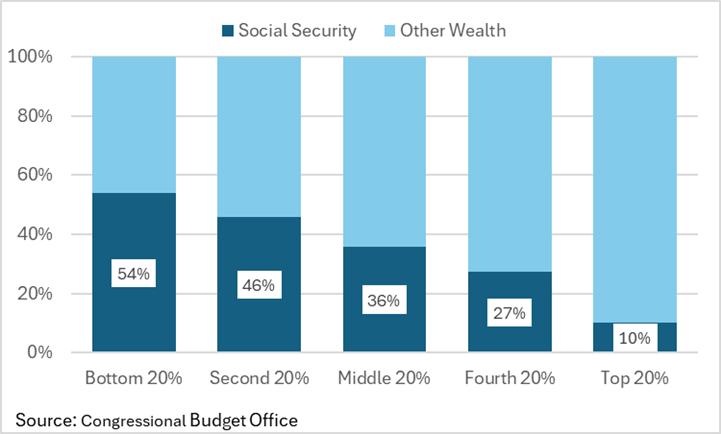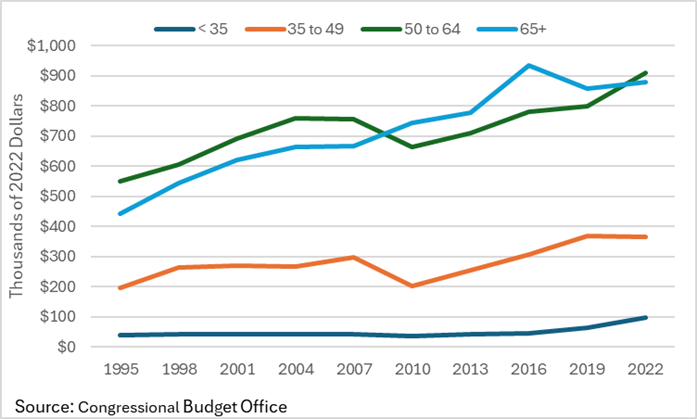Last week, the Congressional Budget Office (CBO), released a report on the distribution of household wealth. Unlike previous reports, this report includes Social Security, which substantially changes both the distribution and the amount of wealth.
According to CBO, total household wealth in 2022 was $199 trillion. That’s nearly eight times the size of the U.S. economy as measured by GDP. Social Security accounts for $39 trillion, or 20 percent of the total.
CBO defines wealth as the value of marketable assets (stocks, bonds, real estate, etc.), plus the present value of defined benefit pensions and Social Security benefits that have accrued to date. These present values represent the lump sum needed to be invested today to fund the share of future benefits that workers have already earned. For example, a 35-year-old who has worked 10 years out of a projected 40-year career would have accrued one-quarter of his or her future benefits. Thus, the present value would equal 25 percent of future benefits (10/40).
Figure 1 shows how Social Security affects the distribution of wealth. Social Security accounts for 54 percent of total wealth among the bottom 20 percent of households; whereas Social Security accounts for 10 percent of total wealth among the top 20 percent of households.
Figure 1: Social Security as Percent of Total Wealth by Household Quintile

Because it accounts for such a substantial portion of total wealth among the lower quintiles, Social Security is likely a major reason for their lower rate of savings. These households have less money to save due to the payroll taxes withheld from their wages, and they have less need to save due to the future benefits they will receive. From the perspective of social insurance programs substituting for personal savings, it could be argued that Medicare should also be included as part of household wealth.
According to a recent Urban Institute report, the present value of Social Security and Medicare (net of premiums) for an average wage worker at age 65 in 2025 is roughly $400,000 and $300,000, respectively. For a married couple with both spouses earning the average wage, the combined value would be roughly $1.4 million. Thus, adding Medicare to household wealth would further shift the distribution from the top to the bottom. But just with the addition of Social Security alone, there has been a substantial increase in wealth among every part of the distribution.
Figure 2 shows how the distribution of wealth changed among household quintiles from 1995 to 2022. The left side shows the wealthiest 20 percent of households gained an increasing share of total wealth. However, total wealth increased from $58 trillion to $199 trillion over that period. Thus, even though households below the top 20 percent received a declining share, total wealth increased enough to allow every quintile to see an increase in their median wealth, as shown on the right side. (The median is the midpoint where half of the households have less wealth, and half have more.)
Figure 2: Change in Share of Wealth and Median Wealth by Household Quintile (1995=1)

When considering the distribution of wealth, it’s important to recognize that wealth varies with age. Those in younger households who are just beginning their career have had very little time to save, and what wealth they have accumulated is likely offset by the debt associated with student loans, and the cost of buying a car, or their first home. Conversely, members of older households are more likely to have substantial wealth due to a lifetime of saving and repaying debt. As a result, households in the lower quintiles are more likely to be younger than households in the higher quintiles.
Figure 3 shows the median wealth among households of different age groups. To better understand how the age of the household affects the distribution of wealth, CBO should consider providing data on the composition of the population by age within each quintile.
Figure 3: Median Household Wealth by Age Category (in 2022 $s)

CBO’s latest report on the distribution of wealth is primarily based on the Survey of Consumer Finances (SCF), which is conducted by the Federal Reserve every three years. CBO has vastly improved the measurement of household wealth by including Social Security. Hopefully, CBO will be able to include Medicare as well when the results of the next SCF are released by the Federal Reserve.




